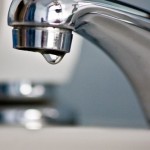
Leaks in drain pipes and water supply pipes can be stopped up with epoxy glue. If possible, shut of the water to that section of the pipe either at the stop, or at the mains. Then clean around the leak and allow it to dry before applying the epoxy. Thorough drying is essential to get a good repair. If using a 2-part epoxy, mix it very thoroughly and paste on to a section of absorbent material such as cotton. Bandage the leak with this glue-soaked fabric. If using ordinary epoxy, wrap several layers of cloth soaked in plenty of glue, around the pipe. If water is still in the pipe you will have to wrap it securely to stop the leak until the epoxy has a chance to set. Same leaks may need to be reinforced with a C-clamp while they set. Bandage as described, then wrap a piece of rubber or other non-porous material around the repair and fix the clamp to the rubber. (This stops the clamp becoming glued to the repair.)
If you have no epoxy handy, a temporary measure is to wrap the crack or hole with several layers of rubber (even cut from a child’s balloon will do) and clamp tightly until a more permanent repair can be made. Use a block of timber to hold the rubber in place. Splitting a length of rubber house and clamping it in place with hose clamps, also helps. A small leak can be stopped for the time by bandaging the effected part with waterproof tape. Ensure that the tape covers several centimeters each side of the hole or crack.
Epoxy repairs cannot be used in joints, where leaks frequently occur. Sometimes the threads on galvanized pipe joints can work loose, allowing water to seep out. Wrap some Teflon tape around the treads of the pipe. This will tighten up the joint and may stop the leak.
Start to screw the pipes together by hand to ensure that the joint goes together freely and not cross-threaded. Use a pair of stilsons to tighten up the joint, one turned in each direction. If this doesn’t stop the leak, there is a special pipe sealing compound witch you can buy to reseal this joint. The compound helps form a water-tight seal and stops the fittings “freezing” together so they can be removed later on if required. A leaking joint should be gently loosened with a pipe wrench or stillsons, the compound applied and the joint re tightened. Also check any connections each side of the repair, as you work may have loosened other joints. A compression fitting may only need a slight tightening to stop a leak. However, if copper tubing leaks at a joint, the joint usually has to be re-soldered.
This involves shutting off the water supply, draining the pipe completely (this is very important as an explosion can occur if the steam is generated in the pipes), and cleaning away the old solder before applying new solder. Steel wool is good material to use, to insure the pipes are thoroughly clean. Always apply a flux to the pipe to ensure a good bound between solder and pipe. apply heat to the joint until the solder melts, ensuring the solder runs freely around the joint. Always fit the joint before heat is applied. Unless you are skilled at soldering, this probably best left to a plumber.

